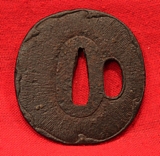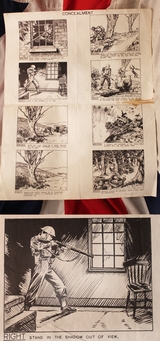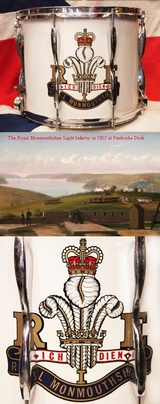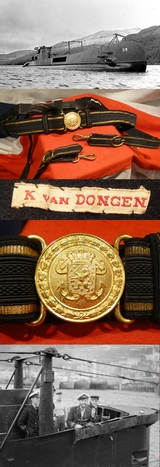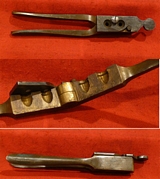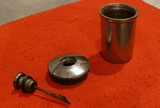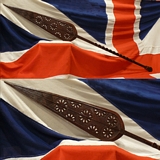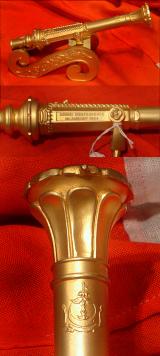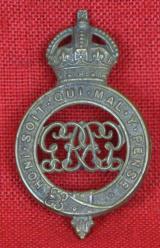Iron Round Chisa Katana or Wakazashi Tsuba With Amidayasuri and Wave Rim
Koto period circa 1550 with very finely chisseled designs. Tsuba are usually finely decorated, and are highly desirable collectors' items in their own right. Tsuba were made by whole dynasties of craftsmen whose only craft was making tsuba. They were usually lavishly decorated. In addition to being collectors items, they were often used as heirlooms, passed from one generation to the next. Japanese families with samurai roots sometimes have their family crest (mon) crafted onto a tsuba. Tsuba can be found in a variety of metals and alloys, including iron, steel, brass, copper and shakudo. In a duel, two participants may lock their katana together at the point of the tsuba and push, trying to gain a better position from which to strike the other down. This is known as tsubazeriai pushing tsuba against each other. read more
375.00 GBP
A Rare and Original British WW2 'Concealment' Instructional Poster for The Camouflage Officer
Original British Army poster. With four fold creases and a little staining. 19 inches x 24 inches read more
195.00 GBP
ERII Drum of the Royal Monmouthsire Royal Engineers Regiment.
An ERII, post 1954 drum of a Welsh Royal Engineers regiment. The Royal Monmouthshire. Top skin needs replacing. A most attractive piece of British Military History. The Royal Monmouthshire Royal Engineers (Militia) (R MON RE(M)) is the most senior regiment in the British Army Reserve, having given continuous loyal service to the crown since 1539. It is part of the reserve forces, and is the only remaining Militia unit in the British Army. The regiment is also unusual in having the word Royal appear twice in its name. It gained the first "Royal" in 1804 when it was known as the Monmouth and Brecon Militia. The second was acquired in 1877 when the regiment transferred from an infantry unit into a Special Reserve section of the expanding Royal Engineers. The top skin in split and would need replacing if it was required to be used as a drum once more. read more
575.00 GBP
An Excellent WW2 Free Dutch Navy, Royal Netherland Navy Submarine Captain's Dress Belt 1930's Used in WW2
The service dress belt of a RNN submarine commander of the Royal Netherlands 'Free' Navy of WW2. Commander of a RNN U Boat, the Free Dutch Navy Submarine of WW2 HNLMS O 19 (N 54). Capt. Van Dongen. Luitenant ter zee 1e klasse (Lt.Cdr.) Karel van Dongen, RNN 0 19, 3 Jul 1939 till 31 May 1941. On 10 May 1940, the day the Germans invaded the Netherlands, the entire mobilization was proclaimed in the Dutch colony. Most Dutch warships, including the O 19, were used to protect allied merchant ships and to patrol the Indonesian archipelago.
The submarine performed multiple patrols and missions in the Pacific theater of World War II, sinking multiple Japanese vessels, attacking shipping convoys and laying mines.
On 8 July 1945, O 19 was en route to Subic Bay in the Philippines at a speed of 16 knots (30 km/h; 18 mph) when it struck Ladd Reef in the South China Sea. Unable to pull free of the reef, the crew of O 19 were rescued by USS Cod. To prevent enemy capture, O 19 was scuttled by her crew using explosives, torpedoes and gunfire An example of the of the calibre of WW2 serving officers who were awarded such a highly respected decoration was the heroic Canadian born, Royal Air Force fighter pilot ace RUSSEL, F/O Blair Dalzell, DSO, DFC (C1319) -
Officer, Order of Orange-Nassau with Swords (Netherlands)
Awarded as per London Gazette dated 23 January 1948 and
AFRO 81/48 dated 6 February 1948.
Public Records Office Air 2/9293 has recommendation drafted when he was a Wing Commander: In operational command of No.126 Wing, Royal Air Force, stationed at the aerodrome Volkel from September 1944 until February until April 1945, through his excellent work has greatly contributed to the liberation of the Netherlands. During World War II, the Order of Orange-Nassau was bestowed upon both members of the Netherlands military and members of foreign services who had helped liberate the Netherlands from Nazi Germany occupation, and those who helped liberate the former Dutch colonies in the Pacific. In the modern age, the Orange-Nassau is still the most active military and civil decoration of the Netherlands, and ranks after the Order of the Netherlands Lion. The Order is typically awarded each year on the Queen's official birthday (April 30) The Order is also used to honour foreign princes, ministers, dignitaries and diplomats.
The Dutch Navy at the beginning of the war with Germany in May 1940, consisted of 1 coastal defence ship, 5 cruisers, 9 destroyers, 27 submarines, 4 gun boats, 6 minelayers and other smaller vessels. The Dutch Navy fought in many parts of sea like North Sea, Mediterranean and the Pacific sea where the Dutch navy had to defend the Dutch colonies from the Japanese advance.
Dutch naval forces had a contribution of sinking many enemy vessels, including 2 U-boats and also Japanese and even Italian submarines. But they also suffered many losses during the war, especially their submarine arm. They lost the coastal defence ship Soerabaja, the 3 cruisers De Ruyter, Java and Sumatra, 9 destroyers, 11 submarines and other smaller vessels. According to records the Royal Dutch Navy lost 59 warships during WWII [40%] Awarded to the Commander of a RNN U Boat, the Free Dutch Navy Submarine of WW2 HNMS O 19 (N 54)
Navy The Royal Dutch Navy
Type Submarine
Class O 19
Pennant N 54
Built by Wilton-Feijenoord (Schiedam, Holland)
Ordered
Laid down 15 Jun 1936
Launched 22 Sep 1938
Commissioned 3 Jul 1939
Lost 10 Jul 1945
Loss position 8? 40'N, 111? 40'E. We also havehis service medal group, for sale seperately read more
225.00 GBP
An Exception Adams Pattern Antique 120 Bore Double Bullet Mould
A singularly fine piece in stunning original patina and it's original bluing to the steel sprue-cutter. This would be absolutely perfect for a cased 120 bore Adams revolver lacking it's mould. Also superb piece for collectors of fine English antique revolver accessories. You simply couldn't find a better example. read more
395.00 GBP
Europe’s Leading Original Samurai Sword Specialists
After 50 years personal experience by Mark, since 1971, we are Europe’s leading samurai sword specialists, with hundreds of swords to view and buy online 24/7, or in our store on a personal visit, 6 days a week. In fact we know of no better and varied original samurai sword selection for sale under one roof outside of Japan, or probably, even within it. Hundreds of original pieces up to 800 years old. Whether we are selling to our clients representing museums around the globe, the world’s leading collectors, or simply a first time buyer, we offer our advice and guidance in order to assist and guide the next custodian of a fine Japanese sword, to make the very best choice for them.
Both of the partners of the company have spent literally all of their lives surrounded by objects of history, trained, almost since birth in the arts and history. Supervised and mentored, first by their grandfather, then their father, who left the RAF sometime after the war, to become one of the leading antique exporters and dealers in the entire world. Selling, around the whole world, in today’s equivalent, hundreds of millions of pounds of antiques and works of art. Both Mark and David were incredibly fortunate to be mentored by some of the world’s leading experts within their fields of antiques and militaria. Mark has been a director and partner in the family businesses since 1971, but long before that he was handling and buying swords and flintlocks since he was just seven years old, obviously in a very limited way though, naturally. David, Mark’s younger brother, also started collecting militaria when he was seven, and as you will by now guess, history, antiques and militaria is simply in their blood. read more
Price
on
Request
A Good Original Antique Nickel G &JW Hawksley Gun Case Oil Bottle
19th century Ideal for all kinds of cased pistols or long guns. Excellent condition. 3cm across [at widest] 5.5cm inches high read more
105.00 GBP
A Beautiful Antique African Tribal Art Carved Paddle-Spear Possiblt From The Itsekiri PeopleOr Even Benin
In carved native wood with geometric carving and piercing. This is a dance paddle of the kind used in ceremonies by the Itsekiri people of the Niger delta. The river was at the centre of tribal society and economy – it provided food and transport for the communities who lived in the area. Canoes were an extremely important part of traditional society and so the paddle was an important symbol for prosperity. Local people relied on the river for their quality of life and believed in water spirits. This paddle is decorated with intricate carving and may have been used in ceremonial dances. Alternatively, it may have been made for trading with Europeans as ethnic objects became fashionable possessions. Although African, like Oceanic art it is often infused with ancestral spirits, as well as spirits of water, air and land. These spirits are contacted in ceremonies to ensure fertility, or invoke protection from famine, disease or enemies.
Sometimes these invocations serve extremely practical purposes. There was a ceremony in Papua New Guinea where ancestral spirits were activated in a carved wooden crocodile. Men carrying the crocodile were then led, like people holding a divining rod are led, to the home of a local murderer.
African and Oceanic art is not only made for decoration. It is made to be used as a tool in the culture. In the 20th century, Cubist painters, and especially Surrealists, were moved by the power of Oceanic abstractions, as they were by traditional African art. This wonderful piece would make a stunning additional display of object d’art in any setting, albeit traditional or contemporary read more
475.00 GBP
A Solid Gilt Bronze, Beautiful, Independence of Brunei 1984 Desk Cannon
In fine deluxe gilt finish, a modern representation of a an early Lantaka Cannon and Carriage, bearing the Royal Crest of the Sultan of Brunei. Especially commissioned for the Independence of Brunei in January 1984. Brunei, officially the Nation of Brunei, the Abode of Peace, it is a country located on the north coast of the island of Borneo in Southeast Asia. Apart from its coastline with the South China Sea, the country is completely surrounded by the insular Malaysian state of Sarawak. It is separated into two parts by the Sarawak district of Limbang. Brunei is the only sovereign state completely on the island of Borneo; the remainder of the island's territory is divided between the nations of Malaysia and Indonesia.. The government is an absolute monarchy under the Sultan, which implements a combination of English common law and sharia law, as well as direct general Islamic practices.
At the peak of the Bruneian Empire, Sultan Bolkiah (reigned 1485–1528) is alleged to have had control over most regions of Borneo, including modern-day Sarawak and Sabah, as well as the Sulu Archipelago off the northeast tip of Borneo, Seludong (modern-day Manila), and the islands off the northwest tip of Borneo. The maritime state was visited by Spain's Magellan Expedition in 1521 and fought against Spain in the 1578 Castilian War.
During the 19th century, the Bruneian Empire began to decline. The Sultanate ceded Sarawak (Kuching) to James Brooke and installed him as the White Rajah, and it ceded Sabah to the British North Borneo Chartered Company. In 1888, Brunei became a British protectorate and was assigned a British resident as colonial manager in 1906. After the Japanese occupation during World War II, in 1959 a new constitution was written. In 1962, a small armed rebellion against the monarchy was ended with the help of the British.
Brunei gained its independence from the United Kingdom on 1 January 1984. 28cm long read more
295.00 GBP
A King George Vth Die Struck Grenadier Guards Pagri Badge
The front has lost its gilt wash due to polishing, the rear has it remaining.The Regiment, as the Royal Regiment of Foot Guards, was formed in 1656 by King Charles the Second who was then in exile in Bruges, Flanders. It was known as the First Guards, later becoming the First Regiment of Foot Guards, and now bears the title "The First or Grenadier Regiment of Foot Guards" in honour or the defeat of the Grenadiers of the French Imperial Guard at the Battle of Waterloo in 1815.
It is the only Regiment in the British Army that has directly gained it's title from the part it played in action. As seen in all of Her Majesty The Queen's ceremonial occasions, such as Changing of The Guard and Trooping the Colour. read more
35.00 GBP


